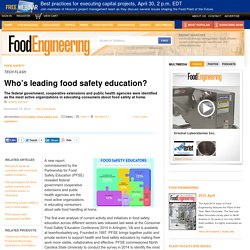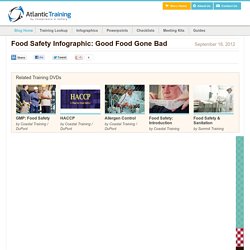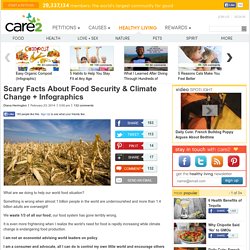

Your Guide to Food Safety [Infographic] [infographic] Five food safety tips for summer grilling. From backyard barbeques to picnic cookouts, Americans celebrate summer by eating outdoors.
![[infographic] Five food safety tips for summer grilling](http://cdn.pearltrees.com/s/pic/th/infographic-association-107021067)
As Americans turn to grilling alfresco, experts at the National Restaurant Association (NRA) offer five food safety tips to ensure safe and memorable summer grilling experiences. (Click on image to enlarge.) Who’s leading food safety education? A new report commissioned by the Partnership for Food Safety Education (PFSE) revealed federal government cooperative extensions and public health agencies are the most active organizations in educating consumers about safe food handling at home.

The first-ever analysis of current activity and initiatives in food safety education across different sectors was released last week at the Consumer Food Safety Education Conference 2014 in Arlington, VA and is available at teamfoodsafety.org. Founded in 1997, PFSE brings together public and private sectors to support health and food safety educators by making their work more visible, collaborative and effective.
PFSE commissioned North Carolina State University to conduct the survey in 2014 to identify the most involved organizations, the audiences they serve and the channels most frequently used to communicate safe food handling messages. According to the survey, in today’s digital environment, most food safety education is done in person. [INFOGRAPHIC] World Health Organization Asks: How Safe Is Your Food? World Health Day was this week, and if anyone understands that there are many paths to good health, it’s the World Health Organization (WHO).
![[INFOGRAPHIC] World Health Organization Asks: How Safe Is Your Food?](http://cdn.pearltrees.com/s/pic/th/infographic-organization-107020805)
This year the global health agency highlighted the importance of keeping food clean and safe, especially as the distance widens between farms and fisheries to a consumer’s plate. “Food production has been industrialized and its trade and distribution have been globalized,” says WHO Director-General Dr. Margaret Chan in a press release from the organization launching its From Farm to Plate, Keep Food Safe campaign. “These changes introduce multiple new opportunities for food to become contaminated with harmful bacteria, viruses, parasites, or chemicals.” “A local food safety problem can rapidly become an international emergency,” adds Dr.
Newsbite: 2012 Food & Health Survey: An Infographic is Worth a Thousand Words - IFIC Foundation - Your Nutrition and Food Safety Resource. Untitled. Food Hygiene: Facts and Figures. Food Safety Infographic: Good Food Gone Bad. By Coastal Training / DuPont by Coastal Training by Summit Training To embed this infographic on your site, simply cost and post the code below.

</p><div align="center"><img src=" width="600" border="0" /></a><br />Featured By: C&S <a href=" Training Videos</a></div><p> Meal planning and organization of cooking meals requires many to commonly plan meals that day and not in advance. Food Issues: Infographic Projects - 7th Grade - EMS. Cesar Chavez.
Infographic: What's Safer and What's Not. [Infographic] 4 steps to food safety from our founding fathers. Food safety is a lot more interesting — and actually kind of cute — when caricatures of George Washington, John Adams, Thomas Jefferson and Benjamin Franklin are the ones providing the info.
![[Infographic] 4 steps to food safety from our founding fathers](http://cdn.pearltrees.com/s/pic/th/infographic-hellawella-107020653)
In recognition of the Fourth of July and as a way to promote the Food Safe Families campaign, the U.S. Department of Agriculture, the Department of Health and Human Services and the Ad Council teamed up to create this patriotic infographic to help you avoid food poisoning. [caption id="attachment_10178" align="aligncenter" width="435" caption="Image: FoodSafety.gov"] [/caption] George Washington provides Step 1: Clean. Wash your hands.Cut away damaged or bruised areas on your produce.Gently rub produce while holding under plain running water.Wash produce BEFORE you peel it.Use a clean vegetable brush to scrub firm produce, such as melons and cucumbers.Dry produce with a clean cloth or paper towel.Throw away the outermost leaves of a head of lettuce or cabbage. John Adams adds Step 2: Separate. Scary Facts About Food Security & Climate Change + Infographics.
What are we doing to help our world food situation?

Something is wrong when almost 1 billion people in the world are undernourished and more than 1.4 billion adults are overweight! We waste 1/3 of all our food; our food system has gone terribly wrong. It is even more frightening when I realize the world’s need for food is rapidly increasing while climate change is endangering food production. I am not an economist advising world leaders on policy. I am a consumer and advocate, all I can do is control my own little world and encourage others to do the same.
These are the steps I take to insure my own food safety and those of our children. 1. Junk food is designed to addict you to sugar, salt and fat so you will eat more and more. Related: Are Food Cravings & Addictions Ruling You? 2. Much of the food we import for our grocery stores comes from countries where people are starving.Food transportation uses up valuable resources.Buy local from Farmer’s Markets. 3. Ensuring The Nation’s Beef Safety [INFOGRAPHIC] Eats_FoodSafetyGov_FoundingFathers.jpg (JPEG Image, 631 × 812 pixels) Infographic-food-water-whats-safer.pdf.